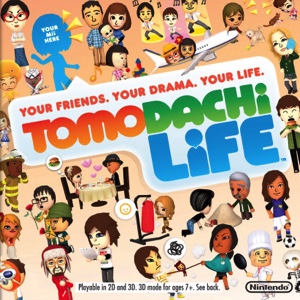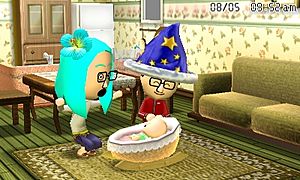Tomodachi Life facts for kids
Quick facts for kids Tomodachi Life |
|
|---|---|

North American cover art
|
|
| Developer(s) | Nintendo SPD |
| Publisher(s) | Nintendo |
| Director(s) | Noriyuki Sato Ryutaro Takahashi Eisaku Nakae |
| Producer(s) | Yoshio Sakamoto |
| Designer(s) | Mai Okamoto |
| Programmer(s) | Takuya Yokota |
| Composer(s) | Daisuke Matsuoka Asuka Ito |
| Series | Tomodachi |
| Platform(s) | Nintendo 3DS |
| Release date(s) |
|
| Genre(s) | Social simulation |
| Mode(s) | Single-player |
Tomodachi Life is a fun social simulation game made by Nintendo for the Nintendo 3DS handheld console. In Japan, it's known as Tomodachi Collection: New Life, and in South Korea, it's called Friend Gathering Apartment. This game is the follow-up to Tomodachi Collection, which was only released in Japan.
The game lets you watch and interact with Mii characters, who live on an island. These characters, called "islanders," build friendships, fall in love, solve problems, and have all sorts of daily adventures. You get to be a part of their lives!
Tomodachi Life first came out in Japan on April 18, 2013. It then launched in North America and Europe on June 6, 2014, in Australia on June 7, 2014, and in South Korea on July 17, 2014. It was very popular, selling over 400,000 copies in Japan during its first week. Worldwide, it has sold 6.72 million copies, making it one of the best-selling 3DS games ever.
The game received many good reviews. People loved its unique gameplay and charming style. Some players wished for more complex mini-games and more control over the Miis. Tomodachi Life also brought new ways to customize Miis. These ideas were later used in other Nintendo games like Miitopia and Miitomo, allowing for even cooler outfits and makeup for your Mii characters.
A new game in the series, Tomodachi Life: Living the Dream, is planned for the Nintendo Switch in Spring 2026.
Contents
Discovering Tomodachi Life
How You Play the Game
When you start Tomodachi Life, you first name your island. Then, you create your "lookalike" Mii, which is like a digital version of yourself. You give your Miis unique personalities by choosing different traits, like how fast they walk or how quirky they are.
You'll be asked to give your lookalike Mii some food and introduce them to a friend. At the Town Hall, you can create even more Miis to live on your island. These Miis will interact in many ways, forming friendships, having fun, and sometimes even having small disagreements. As you play, you'll unlock new places, clothes, food, and special items for your Miis. You can also decorate their apartments.
You earn in-game money by helping your islanders with their problems and giving them gifts. You can also find donations at the Fountain or sell items Miis give you at the Pawn Shop.
Tomodachi Life happens in real-time, just like real life. This means you can play at different times of the day to see new and exciting interactions among your islanders. Over time, Miis will naturally become friends. When two islanders become very close, they might confess their feelings to each other. If successful, they become "Sweethearts" or "Special Someones." This can eventually lead to marriage.
If a married couple lives on your island and you allow it, they might call you to say they've had a baby! You get to name the baby and customize its face. Later, the parents might ask you to babysit, which starts a fun mini-game. Once the child grows up, you can either move them into their own apartment or send them off to explore other players' islands using StreetPass.
Connecting with Others
You can unlock special items and share islanders using SpotPass and StreetPass. Nintendo used to release free SpotPass items every month. These items could be bought in a shop called "Import Wear." The last "Import Item" was released on May 16, 2016, and the service ended.
With StreetPass, you can choose an item to share with other players who are nearby with their Nintendo 3DS systems. This feature also lets you send a married couple's grown-up child to travel to other islands. The Nintendo 3DS Image Share service allowed players to share screenshots from the game on social media like Twitter or Facebook.
Making the Game: Development Story
Tomodachi Life was first released in Japan as Tomodachi Collection: New Life. It was the sequel to the original Tomodachi Collection. On March 13, 2013, Nintendo announced in a Nintendo Direct broadcast that a sequel to Tomodachi Collection would be released. They also showed off two new special edition 3DS LL colors. One of these was a mint white 3DS LL, and the other was part of a special bundle with the new game.
In another Nintendo Direct on April 3, 2013, Nintendo shared more details about the 3DS sequel. They also introduced a special program called Tomodachi Collection: New Life Mii Moving Software. This software let players transfer their Mii data from the first game to the new one and could be downloaded from the Nintendo eShop. The game officially launched in Japan on April 18, 2013.
Bringing Tomodachi Life to the World
Nintendo thought a lot about releasing Tomodachi Collection: New Life in other parts of the world. On January 29, 2014, Satoru Iwata, who was the head of Nintendo at the time, mentioned that the company was working to make Japanese games enjoyable for players everywhere. This was a hint that the game might come out overseas.
Even before Nintendo officially announced it, in March 2014, Nintendo of Europe sent out a survey. This survey included pictures of the game in English, French, and Spanish, showing that a worldwide release was likely.
On April 10, 2014, Nintendo confirmed in a Nintendo Direct that Tomodachi Collection: New Life would be released as Tomodachi Life in North America and Europe. In May 2014, a special playable demo was given to Platinum members of Club Nintendo in North America. The progress from this demo could be transferred to the full game to unlock a bonus item. The game also came with two download codes for a 'Welcome version' demo, which players could share with friends.
Yoshio Sakamoto, a producer known for his work on the Metroid series, said that the idea for the game started with thinking about a DS game that players could enjoy both inside and outside the game. Bill Trinen, a senior director at Nintendo, explained the game's interaction system. He imagined what it would be like if funny videos on YouTube featured people you knew, and those crazy things happened to them. Trinen also shared that Nintendo always tries to create games that appeal to everyone.
One of the biggest challenges was "localization," which means adapting the game for different cultures. For example, a mini-game featuring sumo wrestling in Japan was changed to football in the US. Ryutaro Takahashi, the project director, said that the characters' dialogue was not just directly translated. It was rewritten to sound more natural for each region. Trinen noted that the development of Tomodachi Life was similar to Animal Crossing. The team asked, "How do we make these key moments feel real and important to players in different countries?"
Spreading the Word: Promotion
On April 10, 2014, Nintendo released a Tomodachi Life Direct video on their YouTube channel. It showed Mii characters of Nintendo staff, like Bill Trinen, Reggie Fils-Aimé, and Satoru Iwata, acting like news anchors from the game's "Mii News." This video explained more about Tomodachi Life and the fun of creating Miis of anyone you know.
The American Tomodachi Life website also featured Miis of celebrities. Players could add these celebrity Miis to their game using QR codes. Famous examples included Christina Aguilera and Shaquille O'Neal, each with their own special outfits.
Tomodachi Life's Impact and Friends
Tomodachi Life has left its mark on other Nintendo games. A stage based on the game appears in Super Smash Bros. for Nintendo 3DS and Super Smash Bros. Ultimate. This stage features remixed music and Miis in the background.
Elements from Tomodachi Life are also seen in other titles. In StreetPass Mii Plaza, you can collect a puzzle piece based on the game in Puzzle Swap. Nintendo Badge Arcade includes food items from the Tomodachi series as collectible badges. WarioWare Gold even has a Tomodachi Life-themed microgame. This quick mini-game involves picking things like leaves off a Mii's face, similar to items found in Tomodachi Life. The game's text-to-speech voice also sounds like the one used in Tomodachi Life.
Miitomo, a social networking mobile app for iOS and Android phones, was released in March 2016. The same team that made Tomodachi Life created this app, and it shared many similar ideas. Miitomo was later discontinued on May 9, 2018.
Miitopia, another role-playing video game that uses Miis as characters, was released for the 3DS in Japan in 2016 and worldwide the following year. On February 17, 2021, Nintendo announced that an enhanced version of Miitopia was coming to the Nintendo Switch. This updated game was released on May 21, 2021.
What's Next: The Sequel
On March 27, 2025, Nintendo announced a new sequel called Tomodachi Life: Living the Dream. This announcement was made during a Nintendo Direct presentation. The new game is scheduled to be released for the Nintendo Switch family of consoles in 2026.
See also
 In Spanish: Tomodachi Life para niños
In Spanish: Tomodachi Life para niños
- Miitomo
- Miitopia
- Animal Crossing - Another Nintendo game series where you live with animal characters, which has some similar ideas but a more relaxed feel.


